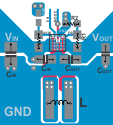JAJSCT0 December 2016 TPS63027
PRODUCTION DATA.
- 1 特長
- 2 アプリケーション
- 3 概要
- 4 標準アプリケーション
- 5 改訂履歴
- 6 Device Comparison Table
- 7 Pin Configuration and Functions
- 8 Specifications
- 9 Detailed Description
- 10Application and Implementation
- 11Power Supply Recommendations
- 12Layout
- 13デバイスおよびドキュメントのサポート
- 14メカニカル、パッケージ、および注文情報
12 Layout
12.1 Layout Guidelines
The PCB layout is an important step to maintain the high performance of the TPS63027 devices.
- Place input and output capacitors as close as possible to the IC. Traces need to be kept short. Routing wide and direct traces to the input and output capacitor results in low trace resistance and low parasitic inductance.
- Use a common-power GND
- Use separate traces for the supply voltage of the power stage; and, the supply voltage of the analog stage.
- The sense trace connected to FB is signal trace. Keep these traces away from L1 and L2 nodes.
12.2 Layout Example
 Figure 21. TPS63027 Layout
Figure 21. TPS63027 Layout